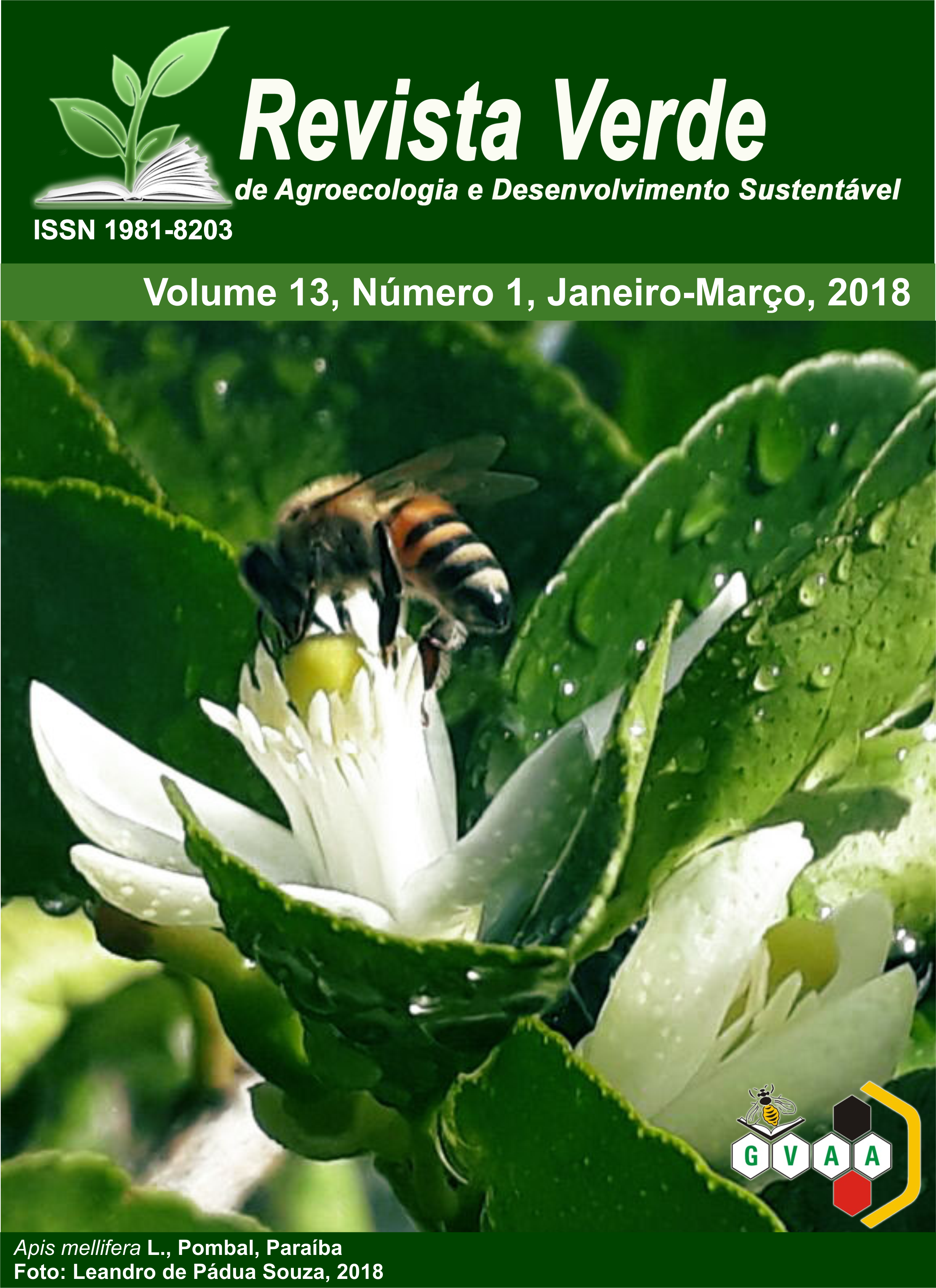Physiological seed quality and initial growth of Handroanthus impetiginosus seedlings under different levels of shading and substrates
DOI:
https://doi.org/10.18378/rvads.v13i1.5348Keywords:
Physiology, Germination, Imbibition.Abstract
The speciesspecies Handroanthus impetiginosus (Mart. ex DC.) Mattos, commonly known as purple ipe, belongs to the Bignoniaceae family. Could be used in recovery of degraded areas, landscaping or in permanent preservation areas, although there is a little amount of information about this species. Our goal in this project was to assess the seeds physiology by imbibition tests and considering germination of purple ipe seeds in different substrates and light restriction levels. For the imbibition test, seeds were immersed in distilled water and placed in two different temperatures (25 and 30 ºC) in a proportion of 100 seeds for 200 ml of distilled water. Checkpoints were set at 2, 4, 16, 24 and 48h. Light restriction tests involved 3 substrates: S1 (Soil), S2 (Sand + coconut fiber), S3 (Sand + Goat Manure) and three light conditions: 0%, 50% e 80%. During 75 days the following variables were considered: height, root collar diameter and leaf number. There were no differences observed between temperatures for the imbibition test and after 48h of imbibition almost became stable for both temperatures. Considering the light restriction test, we can deduce that the seedlings growth rate were affected by the substrates as well for the light conditions. S3 substrate with 50% of shadowing combination provided best outcome results.Downloads
References
ALMEIDA, S. M. Z.; SOARES, A. M.; CASTRO, E. M.; VIEIRA, C. V.; GAJEGO, E. B. Alterações morfológicas e alocação de biomassa em plantas jovens de espécies florestais sob diferentes condições de sombreamento. Ciência Rural, v.35, n.1, p.62-68, 2005.
ALVES, F. J. B.; FREIRE, A. L. O. Crescimento inicial e qualidade de mudas de Ipê-roxo (Handroanthus impetiginosus (Mart. ex DC) Mattos) produzidas em diferentes substratos. Agropecuária Científica no Semiárido, v.13, n.3, p.195-202, 2017.
ATROCH, E. M. A. C.; SOARES, A. M.; ALVARENGA, A. A.; CASTRO, E. M. Crescimento, teor de clorofilas, distribuição de biomassa e características anatômicas de plantas jovens de Bauhinia forticata, submetidas à diferentes condições de sombreamento. Ciência e Agrotecnologia, v.25, n.4, p.853-862, 2001.
BORGES, V. P.; COSTA, M. A. P.C.; RIBAS, R. F. Emergência e crescimento inicial de Tabebuia heptaphylla (Vell.) Toledo em ambientes contrastantes de luz. Rev. Árvore, v.38, n.3, p.523-531, 2014.
BRASIL. Ministério da Agricultura e Reforma Agrária. Secretaria Nacional de Defesa Agropecuária. Departamento Nacional de Defesa Vegetal. Coordenação de Laboratório Ve-getal. Regras para Análises de Sementes. Brasília, 2009. 399p.
CARVALHO, N. M.; NAKAGAWA, J. Sementes: ciência, tecnologia e produção. 4. ed. Jaboticabal: Funep, p.588,
COSTA, C.F. Armazenamento e conservação de sementes de espécies do Cerrado. Planaltina, DF: EMBRAPA Cerrados, 2009. 30p
FRANCO, A. M. S.; DILLENBURG, L. R. Ajustes morfológicos e fisiológicos em plantas jovens de Araucaria
angustifolia (Bertol.) Kuntze em resposta ao sombreamento. Hoehnea, v.34, n.2, p.135-144. 2007.
GRANT, C. A, FLATEN, D. N.; TOMASIEWICZ, D. J.; SHEPPARD, S. C. The importance of early season phosphorus nutrition, Canadian Journal of Plant Science, v.81, p.211-224, 2001.
GUERRA, A.; GONÇALVES, L. G.; SANTOS, L.S.; MEDRI, C. Morfoanatomia de folhas de sol e de sombra de Handroanthus chrysotrichus (MART. EX DC.) Mattos (BIGNONIACEAE). Revista de Saúde Biologica, Paraná, v.10, n.1, p.60-71, 2015.
MAIA-SILVA, C.; SILVA, C. I.; HRNCIR, M.; QUEIROZ, R. T.; IMPERATRIZ-FONSECA, V. L. Guia de Plantas Visitadas por Abelhas na Caatinga. Editora Fundação Brasil Cidadão, Fortaleza-CE,1ª Edição.2012.
MARTINS, L.; LAGO, A. A.; CICERO, S. M. Qualidade fisiológica de sementes de Tabebuia avellanedae e Tabebuia impetiginosa submetidas à ultra secagem. Rev. bras. Sementes, v.33, n.4, p.626-634, 2011.
MARTINS, C. C.; PINTO, M.A.D.S. Armazenamento De Sementes De Ipê-Amarelo-Do-Brejo (Handroanthus umbellatus (Sond.) Mattos. Bignoniaceae). Ciência Florestal, Santa Maria, v.24, n.3, p.533-539, 2014.
MELO, J. T. de; TORRES, R. A. de A.; SILVEIRA, C. E. dos S.; CALDAS, L. S. Coleta, propagação e desenvolvimento inicial de espécies do cerrado. Brasília: EMBRAPA Informação Tecnológica, 2008. 1.279p.
NETO, S. P. M.; GONÇALVES, J. L. M.; TAKAKI, M.; GONÇALVES, J. C. Crescimento de mudas de algumas espécies arbóreas que ocorrem na mata atlântica em função do nível de luminosidade. Revista Árvore, v.24, n.1, p.35-45, 2000
OLIVEIRA, A. K. M.; PEREZ, S. C. J. G. A. Crescimento inicial de Tabebuia aurea sob três intensidades luminosas. Ciência Florestal, v.22, n.2, p.263-273, 2012.
OLIVEIRA, F. L. G.; MANO, A. R. O.; SOUZA, M. G. F.; LIMA, F. G.; LIMA, F. A. M. Efeito do substrato na germinação de sementes de Tabebuia impetiginosa (Mart. Ex DC.) Standl (Bignoniaceae). In: 64º Congresso Nacional de Botânica, Belo Horizonte, p. 10-15, 2013.
PINTO, J. R. S.; DOMBROSKI, J.L.D.; FREITAS, R. M. O. Crescimento e índices fisiológicos DE Tabebuia aurea (Manso) Benth. & Hook., sob sombreamento no semiárido. FLORESTA, v.46, n.4, p.465, 2017.
PIVA, R. Adubação de videiras cultivares Isabel e Bordô (Vitis labrusca L.) em sistema orgânico de produção. Guarapuava: 2011. 50.f. Dissertação (Mestrado em Agronomia, área de concentração em Produção Vegetal) -Universidade Estadual Do Centro-Oeste, Guarapuava.2015
SALOMÃO, A. N.; FUJICHIMA, A. G. Respostas de sementes de Tabebuia aurea (Silva Manso) Benth. & Hook. F. ex S. Moore (Bignoniaceae) à dessecação e ao congelamento em temperaturas subzero. 76. ed. Brasilia: EMBRAPA, 2002.
SCHULZE, M.; GROGAN, J.; UHI, C.; LENTINI, M.; VIDAL, E. Evaluating ipê (Tabebuia Bignoniaceae) logging in Amazônia: sustainable management or catalyst for forest Degradation? Biological Conservation, v.141, p.2071-2085, 2008
SIEBENEICHLER, S., FREITAS, G., SILVA, R., Adorian, G. and Capellari, D. Características morfofisiológicas em plantas de Tabebuia heptaphyilla (vell.) tol. em condições de luminosidade. Acta amazônica, v.38, n.3, p.467-472, 2008.
RAMOS, J. D.; CHALFUN, N. N. J.; PASQUAL, M.; RUFINI, J. C. M. Produção de mudas de plantas frutíferas por semente. Informe Agropecuário, v.23, n.216, p.64-72, 2002.
TAIZ, L.; ZEIGER, E. Plant Physiology. 3rd edn. Sunderland: Sinauer Associates, 690 pp.
VALLADARES F.; SALDAÑA A.; GIANOLI, E. Costs versus risks: architectural changes with changing light quantity and quality in saplings of temperate rainforest trees of different shade tolerance, Austral Ecology, v.36, 2011.















